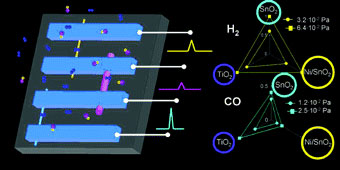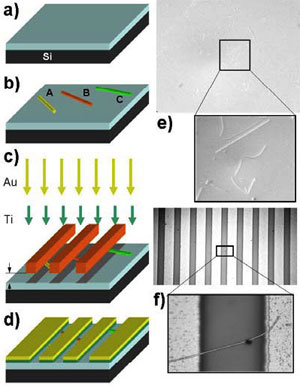| Posted: Jul 24, 2006 | |
Towards the nanoscopic electronic nose |
|
| (Nanowerk Spotlight) The concept of e-noses – electronic devices which mimic the olfactory systems of mammals and insects – is well developed and has become a booming area of research thanks to a better understanding of the reception, signal transduction and odor recognition mechanisms for mammals, combined with achievements in material science, microelectronics and computer science. Researchers have now started replacing the sensing elements in e-noses with nanowires, achieving excellent sensing performance which is comparable or even better compared to the best thin film counterparts. | |
| The application of semiconductor oxide nanowires as solid-state chemical sensors is an area of apparent technological promise. With the great progress achieved recently in the development of the effective growth techniques and proven sensing performance the focus in research is shifted towards the better understanding of the fundamentals of surface reactivity of low dimensional nanostructures. | |
| Andrei Kolmakov, an assistant professor in the physics department at Southern Illinois University at Carbondale, explains his group's recent findings to Nanowerk: "The core of our research was to show that metal oxide nanowires can be used as a platform for the fabrication of the next generation ultra small e-noses and probably substitute in the future the current devices based on thin (or thick) polymer or oxide films." | |
| "To make this kind of device operational one has to use an array of sensing elements which have a, at least somewhat, different response to the same target gas" says Kolmakov. "That is why along with pristine SnO2 and In2O3 nanowires we also fabricated and tested sensing properties of new nano- and meso structures such as TiO2 single crystal whiskers and SnO2 nanowires doped with Ni/NiO nanoparticles to diversify the responses in our array of sensors." | |
 |
In a recent paper, titled "Toward the Nanoscopic "Electronic Nose": Hydrogen vs Carbon Monoxide Discrimination with an Array of Individual Metal Oxide Nano- and Mesowire Sensors",Kolmakov's students Bradly Button, Kelly Wepsiec and another key contributor, visiting researcher Dr. Victor Sysoev from the Saratov State Technical University in Russia, presented a comparative study of gas-sensing properties of individual SnO2, In2O3, and TiO2 nano- and mesowires placed on the same chip and wired as an array of chemiresistors. |
| The response of a three-chemiresistor array to H2 (top) and CO (bottom) inputs, normalized by maximum value. (Reprinted with permission from American Chemical Society) | |
| Both hydrogen and carbon monoxide increase the conductance of the chemiresitors, and the magnitude of this change is controlled by the surface reactivity to the specific gas and also by gas concentration. Thus, as in the case of thin film sensors, the selectivity of the individual nanostructure is not sufficient to discriminate between them. | |
| "However" says Kolmakov, "the gas recognition can be achieved using well-established methods realized for electronic noses. Namely, signal patterns can be depicted for these three sensing elements as radial plots: each radial beam shows the signal of one single sensing element normalized to its maximum value. As can be seen from above figure, the radial plots of H2 and CO gas responses over the chemiresistor array are prominently different for two gases." | |
| Apparently, increasing the number of nanostructures assembled as an array should lead to higher degree of gas discrimination. | |
 |
The fabrication protocol of the array of chemiresistors out of different metal oxide nano- meso-wires. a) Pristine Si/SiO2 wafer b) Nanostructures from different materials were placed of few separated areas on the chip c) A single shadow mask was used to determine the metal contacts. e) Optical microscope large scale image of the sample with the distribution of the nano- and meso- structures f) large area electrode pads contacting long chemiresistors. Such metal leads can be used both for wire bonding and inside the probe station. The distance between the electrodes is 45 micrometers. (Reprinted with permission from American Chemical Society) |
| Demonstrating the feasibility of this nanostructure array opens a promising path toward the development of a robust nanoelectronic nose device. | |
| Kolmakov is enthusiastic about the future developments for e-noses: "Taking into consideration the phenomenal progress achieved recently by many groups and research centers in fabrication and architectonics of nanostructures and nanostructure devices it is safe to predict that e-noses made of arrays of thousands reliable, robust nanowire sensors will be fabricated on a single chip. Devices with such a degree of complexity (though being less complex than the olfactory system of insects) linked to modern signal processing and picture recognition systems will be used in robotics, homeland security, medicine, food processing etc." | |
| The next challenge for the researchers is improving the selectivity of the nanowire sensors. | |
 By
Michael
Berger
– Michael is author of three books by the Royal Society of Chemistry:
Nano-Society: Pushing the Boundaries of Technology,
Nanotechnology: The Future is Tiny, and
Nanoengineering: The Skills and Tools Making Technology Invisible
Copyright ©
Nanowerk LLC
By
Michael
Berger
– Michael is author of three books by the Royal Society of Chemistry:
Nano-Society: Pushing the Boundaries of Technology,
Nanotechnology: The Future is Tiny, and
Nanoengineering: The Skills and Tools Making Technology Invisible
Copyright ©
Nanowerk LLC
|
|
Become a Spotlight guest author! Join our large and growing group of guest contributors. Have you just published a scientific paper or have other exciting developments to share with the nanotechnology community? Here is how to publish on nanowerk.com.
